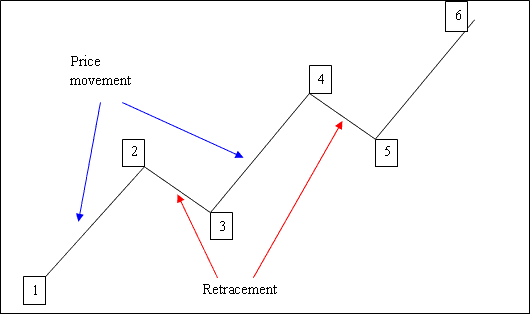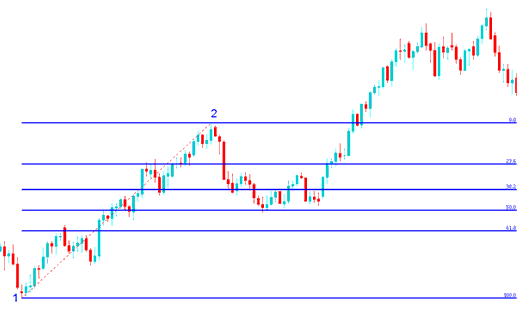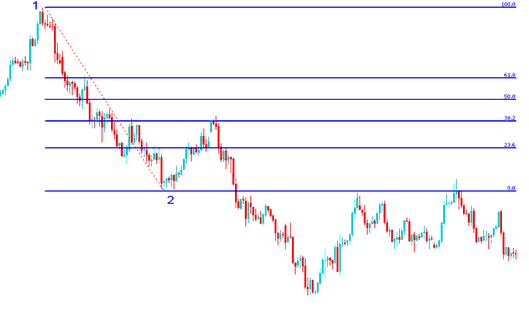Drawing Fib Retracement Areas on Upwards and Downwards Trend
The trajectory of a stock price on its chart does not manifest as a straight ascension or descent: rather, it follows an oscillating, zigzag pattern. Fibonacci Retracement serves as the instrument to forecast the probable stopping points of this zigzag movement. The key pullback levels identified are 38.2%, 50%, and 61.8%, which represent anticipated retracement points in the stock trading arena.
What is retracement? It is a retracement of the stock price before the stock market resumes original trend/original direction of movement.
Explanation of Zigzag Movement: The Examples below shows stock trading price heading upwards in a zigzag manner.
The diagram below shows movement in an upwards market.

1-2: Indices Price moves up
2-3: Pullback
3-4: Moves up
4-5: Pull back
5-6: Moves up
seeing that we can pick out where a retracement starts on a chart, how do we recognize where it will get to?
The answer is we use Fibonacci retracement indicator.
This is a type of line study used in indices trading to predict & calculate these levels. This stock indicator is placed directly on the stock chart within the platform provided by your broker, This stock indicator will then automatically/mechanically calculate these levels on the chart.
What are The Retracement Levels
- 23.6 %
- 38.2%
- 50.0 %
- 61.8%
38.2% and 50.0% Levels are the most used and most of the time this is where the pull back will get to. With 38.2% being the most popular/liked & most widely used.
61.8% is also oftenly used to set stops for trades opened using this strategy.
This tool will be drawn in direction of the market price trend as described in the exemplification laid-out below.
How to Draw on an Upwards Bullish Market
In the diagram below the stock trading price is moving up between 1 and 2 then after 2 it retraces downward to 50.00% pull-back area then it continues heading upward in the original and initial upward trend. Notice that this indicator is drawn and plotted from point 1 to point 2 in the direction of the market trend (Upward).
Recognizing this movement as a retracement based on the strategy employing this specific technical indicator, we would place a buy order situated strategically between the 38.2% and 50.0% retracement levels, with our stop loss positioned just below the 61.80% pullback threshold. Had a buy trade been executed at this juncture in the trade examples provided below, substantial pips would have been gained.

Explanation for the Above Example
Once the trade transaction hit the 50.0 % level, this zone provided a lot of support for price, & afterwards the stock trading market then resumed the original up trend & continued to move upwards.
23.6% provides minimum support & isn't an ideal place which to place an order.
At 38.2%, it offers some support. But in this case, the stock price pulled back to 50%.
50.00% gives a lot of support & in this case, this was the appropriate factor to set a purchase order.
In this particular instance, the price pullback extended to the 50.00% retracement mark. However, in the majority of stock market scenarios, retracements only reach up to 38.2%, leading many traders to place their buy limit orders precisely at this 38.2% level, simultaneously setting a stop-loss order just beneath the 61.8% level.
How to Draw on a Downwards Bearish Market
In the chart below, the stock market drops from point one to two. After two, it pulls back to a 38.2 percent retracement level. Then it resumes the down move in the main trend. See how this tool draws from one to two, along the trend's down path.
Because we know this is just a retracement we put a sell order at 38.20% level and a stop loss order just above 61.80%.
If you had placed a sell order at the 38.20% level, like shown in the trade here, you would have earned a lot of pips after that. In this trade, the price went back up to the 38.2% level and didn't reach the 50.00% level. From what I've seen, it's usually a good idea to use 38.20% because the price often doesn't go all the way back to the 50.0% level.

Explanation for the Above Example
The preceding illustration provides an excellent schematic where the stock trading price reverses direction immediately upon intersecting the 38.2% Fibonacci Level.
This level provided a lot of resistance for the pull back, this was the best place for an investor to place a sell limit order as the stock trading market quickly moved down after hitting this level.
Get More Topics and Guides:
- How to Analyze an Upwards Index Trend in a Index Chart
- How can I see Nasdaq on the MT5 iPad app?
- Insert Menu Options in MetaTrader 4 Trade Software Explained
- Index Periodicity Tool Bar Menu
- Introduction to MetaTrader 4 Index Trade Platform/Software Interface
- How Can I Add EU50 in MetaTrader 4 Android App?
- Best Stock Index Strategies For Trading UKX 100
- Indices Charts Analysis of Index Setups Training Guide
- How to Interpret Reversal Patterns
- Trading Based on Signals Generated by the MACD Indicator.

